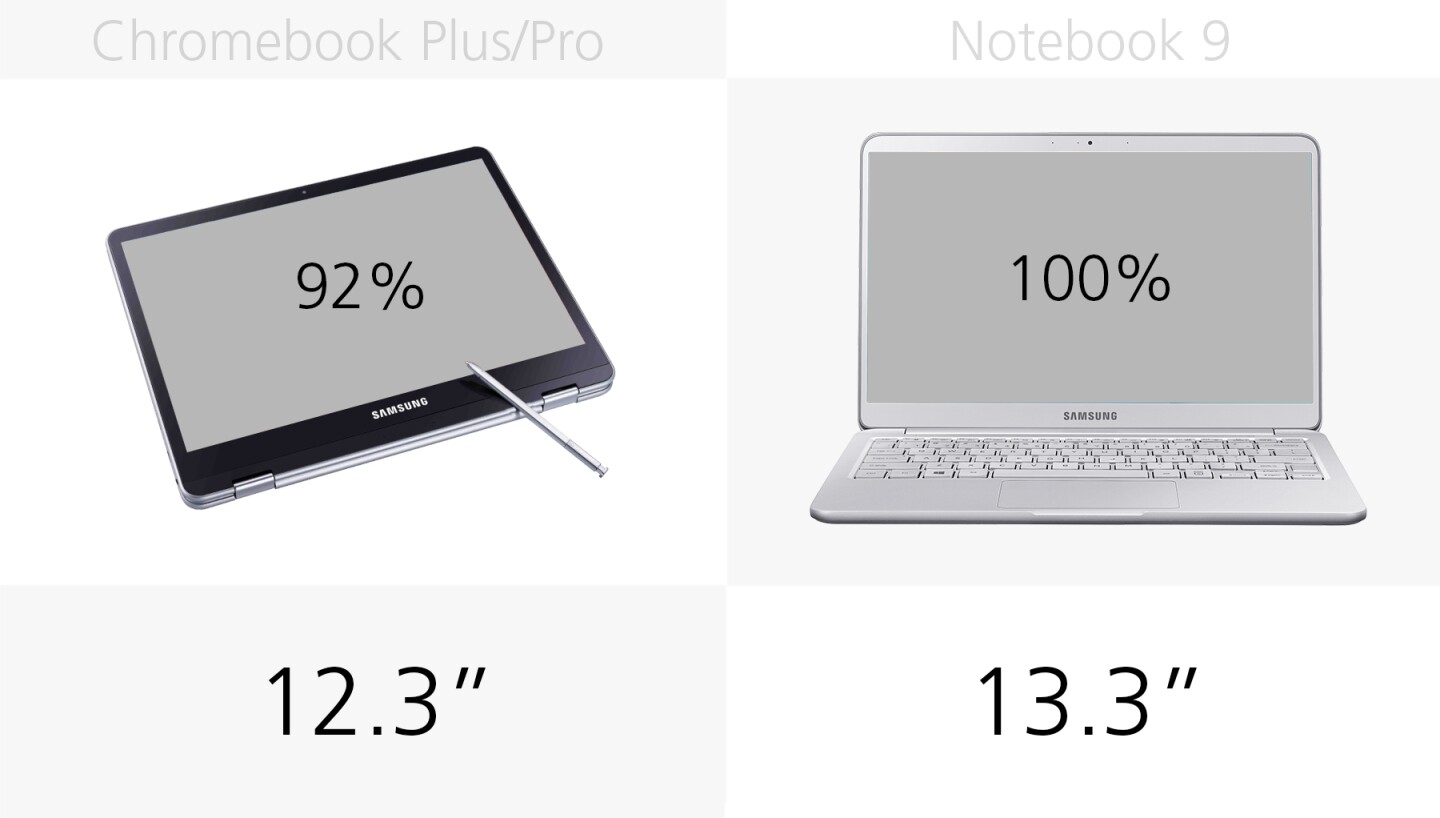Amidst its smartphone woes and headlining home appliances, Samsung is quietly updating its laptop lineup in the early part of 2017. Here's how its Chromebook Plus and Pro (identical except for their processors) stack up against the updated, ultra-light 13-inch Notebook 9.
Size

When closed, the two machines are an identical 13.9-millimeters thick. However, the Chromebook Plus/Pro stands about 7-percent taller and 9-percent less wide than the Notebook, when held in a landscape orientation.
Form factor

This Chromebook is a 2-in-1 convertible. The full-sized keyboard and trackpad fold 360° behind the touchscreen display, so the device can be held and used like a tablet or propped up in a number of other positions.
The Notebook 9 has a traditional laptop form factor without a touchscreen, though it is slightly more flexible than others. Its hinge opens to a full 180-degrees so the machine can lay fully flat.
Build/colors

Both machines are built from magnesium alloy, but in different colors. The Chromebook Plus/Pro is silver. In the US market, the Notebook 9 is a grey-white color called "titan". Some international customers may have a metallic blue option as well.
Weight

Chromebook's flexible form factor comes at a price: It weighs nearly 32-percent more than the ultralight Notebook 9. That's a difference you may feel if you're lugging it around in a shoulder bag all day.
Display size

The Notebook 9's display is 8-percent larger than that of the Chromebook, thanks to its longer diagonal and 16:9 aspect ratio. The Chromebook's aspect ratio is 3:2.
Display resolution

This Chromebook packs in considerably more pixels. We didn't have any complaints about the Notebook 9's display during our brief hands-on period, but the sharper resolution on the Chromebook should be noticeable during tablet viewing, when it's held closer to the face.
Stylus

The Chromebook has an active stylus with 2,048 sensitivity levels, which can be used for taking notes or drawing on the touchscreen. It snaps cleanly into a storage compartment built into the side of the machine. There is no stylus or touchscreen support on the Notebook 9.
Processor

The Chromebook Plus and Pro are identical on every spec except for their processors. The Plus will have a Chromebook-specific ARM OP1 chip, while the Pro's Intel Core m3 processor is closer to the type typically found in laptops.
The Notebook 9 uses the latest generation of the Intel Core i5 or i7 processors. The i7 is the more powerful option, but Samsung has not posted clock speed estimates.
RAM

Chromebooks are only available with 4 GB of RAM. The Notebook 9 is available with "up to" 8 GB or 16 GB of RAM for its i5 and i7 variants, respectively, which suggests that entry-level models may start with less.
Storage

There is one storage level for the Chromebooks: 32GB. Of course, Chromebooks are designed to depend on the cloud, so on-board storage is at less of a premium.
Again, Samsung issued an "up to" 256 GB spec for the Notebook 9. We don't know exactly which configurations will be available off the shelf, but the spec sheet left the door open to the starting point(s) being lower than the 256 GB mark.
microSD

Both machines complement their built-in storage with a microSD card slot.
Battery

The Chromebook has a bigger battery, and if Samsung's estimates are to be believed, slightly longer life. Still, "up to 8 hours" isn't that big of an advantage over "7 hours" and neither of them are likely to get you through an entire work day without a charge.
Ports

The Chromebook keeps things minimal with two USB-C slots (one on either side). There's no dedicated charging port, but either USB-C port works for charging.
The Notebook is more generous with its expansion options. It has a dedicated charging port, but the machine can also be charged over USB-C (and it supports fast-charging for both ports). It also includes two legacy USB 3.0 ports and an HDMI slot, so you won't need to rely heavily on adapters.
Fingerprint sensor

There are no biometric login options on the Chromebook, but the Notebook 9 has a built-in fingerprint sensor for logging in securely without entering a password.
Software

The Chromebook runs Chrome OS and is Samsung's first to include support for Android apps from the Google Play store at its release. Its operating system is strictly mobile, but it's shaping up to be a versatile one.
The Notebook 9 is a fully desktop machine and ships with Windows 10 Home.
Release

So far, Samsung has only announced a release date for the Chromebook Plus, which will hit shelves sometime in February. The more powerful Chromebook Pro and Notebook 9 are expected sometime within the first half of 2017.
Starting price

At this point, the only price we're certain of is the Chromebook Plus, which will start at US$449. Samsung has yet to release pricing of the Chromebook Pro or the Notebook 9.
It will be interesting to see the price difference between the Intel-powered, Android-supporting Chromebook and the Notebook 9 laptop. As the lines between Chromebooks and laptops blur, it's possible their prices will inch closer – though laptop-rivaling prices would make top-shelf Chromebooks a harder sell.
For more about these products, read New Atlas' hands-on impressions from CES 2017.





















